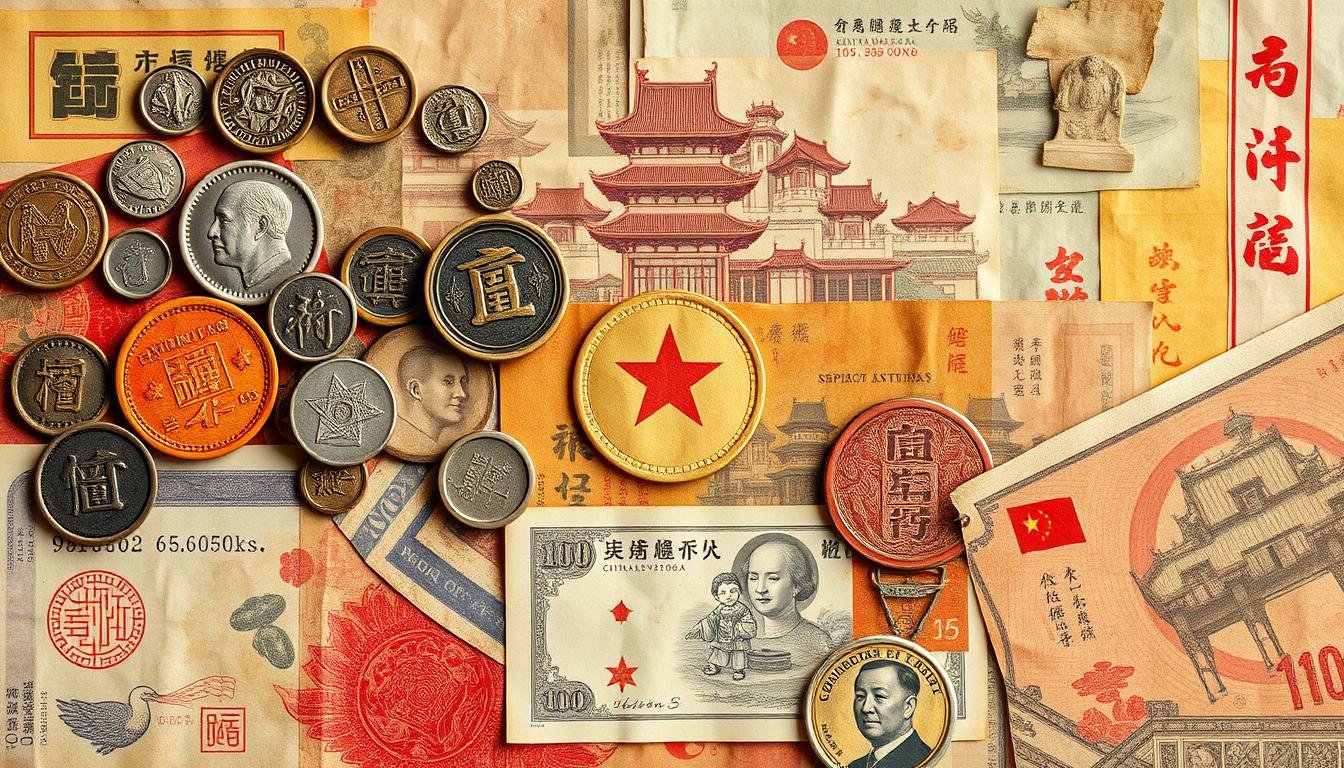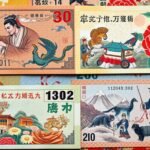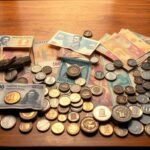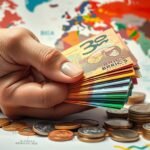
Exploring China’s currency history reveals a journey of significant changes. Early currencies included cowrie shells and leather money1. These were used in various transactions, with silver and copper being the primary mediums2. The evolution of Chinese currency is a complex and intriguing subject. It spans through different dynasties and regimes, making it a captivating exploration of Chinese monetary history.
Understanding China’s currency history is key to grasping its economic development. It also sheds light on its global economic impact. The introduction of Chiang Kai-shek’s fiat currency marked a shift towards government-issued money2. The use of paper currency in China began during Emperor Zhenzong’s reign1.
Key Takeaways
- The history of China’s currency is a complex and fascinating topic, with various dynasties and regimes contributing to its development, including the Qing Dynasty, which lasted from 1644 to 19112.
- Early forms of currency included cowrie shells and leather money1, which were used for various transactions.
- The implementation of Chiang Kai-shek’s fiat currency led to the gradual replacement of private money2.
- Paper currency was introduced in China during the reign of Emperor Zhenzong1.
- The study of the history of China’s currency is essential to understanding the country’s economic development and its impact on the global economy, making the history of China’s currency and Chinese money history a vital area of study.
- The gold standard was introduced in the United Kingdom in 1821 and later adopted by other countries, including Germany, France, and the United States1.
- Hyperinflation occurred during the Yuan and Ming dynasties, creating reluctance towards government-issued fiat money2.
The Origins of Currency in Ancient China
Exploring the history of currency in ancient China reveals a journey spanning over 3000 years, from ancient times to the modern era3. The evolution of money in dynastic China is remarkable, starting with bartering, cowrie shells, and bronze money.
The Shang Dynasty (c. 1600 – 1046 BCE) saw the introduction of cowrie shells as a form of exchange3. This period also marked the beginning of bronze objects, like spades and knife-shaped coins, circulating alongside cowries3. The Warring States Period (c. 475 – 221 BCE) introduced various local coinages by competing states3.
The Qin dynasty (221–206 BCE) is significant for the introduction of standardized coinage4. Chinese coins were cast in molds, unlike European coins which were cut and hammered4. The Tang dynasty saw the invention of paper currency, further evolving money in dynastic China5.
The history of currency in ancient China is both captivating and complex. It spans from cowrie shells to bronze money and eventually, paper currency. This evolution reflects China’s rich history and cultural heritage345.
| Period | Currency |
|---|---|
| Shang Dynasty | Cowrie shells, bronze objects |
| Warring States Period | Local coinages |
| Qin dynasty | Standardized coinage |
The Revolutionary Invention of Paper Money During the Tang Dynasty
As you explore the evolution of renminbi, understanding the Tang Dynasty’s role in China’s monetary history is key. The invention of paper money during this era was a major milestone in the yuan development timeline. Initially, merchants used promissory notes, a precursor to paper currency6. This innovation streamlined trade and commerce, setting the stage for paper money’s widespread use in later dynasties.
The advent of paper money significantly impacted China’s economy, introducing greater flexibility and convenience in transactions. The Song Dynasty saw a rise in paper note usage, with the establishment of factories for printing7. The Yuan Dynasty then printed more chao, leading to inflation6. The evolution of renminbi showcases China’s monetary system’s adaptability and resilience.
Key milestones in paper money development include:
- The use of leather money in 119 B.C. under Emperor Wu Ti of the Western Han Dynasty8
- The invention of paper money proper around A.D. 2008
- The establishment of a special Central Administration Office for issuing ‘Convenience Money’ during the Northern Sung8
Theyuan development timelineis a complex and fascinating narrative, with the Tang Dynasty playing a critical role in introducing paper money. As you continue to explore China’s currency history, you’ll uncover the complex interplay of economic, social, and political factors that have shaped theevolution of renminbi.
The Evolution of Chinese Monetary Systems Through Major Dynasties
Exploring the history of China’s currency reveals the impact of various dynasties. The Song, Yuan, Ming, and Qing dynasties each played a role in shaping Chinese monetary systems. The history of China’s currency is rich and complex, with each dynasty contributing to its development. The Song Dynasty introduced paper money, known as jiaozi, a significant milestone in Chinese money history9.
The Yuan Dynasty issued different types of paper money, including zhongtongchao, zhiyuanchao, and zhizhengchao9. The zhidachao was issued annually, a response to the coup of the third Khan, Külüg, in 13109. The Ming Dynasty implemented currency reforms, while the Qing Dynasty struggled with inflation and devaluation. The government used the Kuping tael unit for tax revenue, which was slightly larger than the unit for expenses10.
The evolution of Chinese monetary systems through major dynasties showcases China’s rich history of China’s currency. The use of copper cash, silver ingots, and paper money shaped the Chinese money history. As you continue to explore, you’ll understand the complex factors influencing Chinese monetary systems10.
The Complete History of China’s Currency: From Ancient Times to Modern Era
Exploring the chronology of Chinese currency reveals a deep and complex history spanning millennia. China’s monetary system has evolved significantly, influencing its economy and trade. The modern Chinese monetary system reflects these transformations, with contributions from various dynasties and regimes11.
The history of Chinese currency is marked by the use of materials like copper, silver, and paper. The Ming dynasty saw the widespread use of copper coins, while the Tang dynasty introduced paper money12. This evolution is a captivating narrative, featuring diverse forms of currency, including cowrie shells, bronze coins, and banknotes12.
China’s monetary system development has been shaped by trade, politics, and technology. The advent of paper money was a groundbreaking innovation, facilitating more efficient trade and commerce12. Today, the modern Chinese monetary system is advanced, featuring various denominations and security measures to combat counterfeiting12.

- The introduction of cowrie shells as a form of currency around 1200 BCE12
- The development of bronze coins during the Shang dynasty12
- The introduction of paper money during the Tang dynasty12
- The use of copper coins during the Ming dynasty11
These milestones have shaped the chronology of Chinese currency and contributed to the modern Chinese monetary system11.
The Birth of the Modern Yuan: Republican Period Transitions
The Republican Period was a critical time in the renminbi historical background, introducing the yuan as China’s official currency13. This era was marred by economic hurdles, including inflation and currency devaluation14. The Nationalist government undertook currency reforms to stabilize the economy and boost trade13.
The yuan development timeline during this period saw China shift from a fiat currency to the renminbi14. The renminbi’s introduction in 1948 was a major turning point in monetary history14. Initially pegged to the US dollar, it later transitioned to a market-oriented system14.
Some key events in the yuan development timeline include:
- The introduction of the renminbi in 194814
- The pegging of the renminbi to the US dollar14
- The transition to a market-oriented system14
The Republican Period set the stage for the modern yuan, with its renminbi historical background influencing China’s economic growth13. Grasping the yuan development timeline is vital for understanding China’s monetary system complexities14.
| Year | Event | Impact on Yuan |
|---|---|---|
| 1948 | Introduction of renminbi | Marked the beginning of a new monetary era |
| 1955 | Revaluation of yuan | Stabilized the economy and promoted trade |
Communist Revolution and Currency Reform
The Communist Revolution significantly shaped the renminbi’s evolution, marking a critical juncture in China’s monetary history. This event profoundly impacted the country’s economic landscape15. The introduction of the renminbi as China’s official currency aimed to stabilize the economy and foster growth.
The Communist government introduced reforms, including the establishment of the People’s Bank of China. This move was to oversee monetary policy and regulate the financial sector. These reforms have been instrumental in the growth of the modern Chinese monetary system, with the renminbi at its core16. Economic reforms also led to a significant rise in the standard of living, with per capita income seeing substantial increases16.
Some key statistics highlighting the impact of the Communist Revolution on China’s economy include:
- Introduction of the renminbi as the official currency
- Establishment of the People’s Bank of China to oversee monetary policy
- Implementation of economic reforms to promote growth and stability
The evolution of the renminbi has been influenced by these reforms. The modern Chinese monetary system remains essential to the country’s economic development15.
The Communist Revolution’s impact on China’s monetary system has been immense. The introduction of the renminbi and the establishment of the People’s Bank of China were significant milestones in the evolution of the modern Chinese monetary system16. As China continues to grow, the renminbi is set to remain a significant player in the global economy, with its value and influence evolving over time15.
The Emergence of the Renminbi as a Global Currency
The history of China’s currency is filled with key milestones. The rise of the renminbi as a global currency stands out. As it gains traction in international trade and finance, its influence on the global economy grows17. The renminbi’s role in China’s trade has seen a significant increase, from almost zero to nearly 10% between 2010 and 201217.
The internationalization of the renminbi is also seen in Hong Kong’s renminbi-denominated deposits, which hit around $100 billion in 201117. The renminbi’s role in global trade is expected to expand further. China could surpass the United States as the largest economy by 201617. As the renminbi’s use in international trade grows, its exchange rate policies will be critical in shaping the global economy18.
International Trade Impact
China’s large trade surplus has driven the renminbi’s growing importance in international trade18. This surplus has significantly increased China’s foreign exchange reserves18. The renminbi’s exchange rate policies have also been key in shaping the global economy. The currency has appreciated by about 25% against the US dollar from mid-200518.
Digital Transformation of Chinese Currency
The digital transformation of Chinese currency is a significant milestone in the evolution of renminbi. The yuan development timeline marks important stages in this process19. The People’s Bank of China (PBoC) has been leading this effort by developing the digital yuan, also known as the Digital Currency Electronic Payment (DCEP) system20.
This system has been piloted in several major cities, including Shenzhen, Suzhou, and Xiong’an. The goal is to reduce banking costs and increase transaction efficiency20. Digital payments in China have surged, accounting for over 85% of all payments in 2021. The digital yuan is expected to play a significant role in this trend20.
Some key features of the digital yuan include:
- Direct peg to the Chinese yuan, ensuring stability and facilitating easier transactions20
- Reduced banking costs, with an expected decrease of 15% to 20% within the next five years20
- Increased adoption rate, with around 260 million individuals having opened digital yuan wallets as of mid-202320
The digital transformation of Chinese currency is a critical step in the yuan development timeline and the evolution of renminbi. It has significant implications for the future of money and finance in China19.
| Year | Digital Yuan Milestone |
|---|---|
| 2014 | People’s Bank of China (PBoC) starts digital currency initiative19 |
| 2016 | PBoC builds digital yuan prototype19 |
| 2019 | Large-scale pilot for digital yuan launched in several cities19 |
| 2021 | Digital yuan wallets opened by around 260 million individuals20 |
The Yuan’s Role in Modern Global Economics
Exploring the modern Chinese monetary system reveals the yuan’s significant role in global economics. The renminbi’s historical background and its effects on international trade and finance are critical. The yuan, ranking ninth globally and the top in Asia, shows its growing influence21. The offshore renminbi market’s expansion also indicates a rise in its sway over other Asian currencies21.
China’s monetary policy, led by the People’s Bank of China (PBOC), plays a key role. The PBOC regularly reports increases in foreign exchange reserves, such as adding around $10 billion monthly22. Yet, significant reserve sales, like the $43 billion in the third quarter of 2023, also occur22. These changes highlight the yuan’s complex role in global economics.
Recent studies suggest the yuan’s exchange rate must stay within a two-percentage point band around the daily fix22. This, along with its growing influence on Asian currencies, emphasizes the need for a deeper understanding of the yuan’s role. The renminbi historical background and the modern Chinese monetary system are essential for this understanding.
The table below summarizes key statistics about the yuan’s role in global economics:
| Category | Statistic |
|---|---|
| Renminbi ranking | Ninth most traded currency globally21 |
| Offshore renminbi market | Grown considerably, with an upward trend in influence21 |
| PBOC foreign exchange reserves | Added around $10 billion a month22 |
In conclusion, the yuan’s role in modern global economics is complex and multifaceted. It is influenced by China’s monetary policy and the renminbi’s growing influence on Asian currencies. As you continue to explore the modern Chinese monetary system, understanding the renminbi’s historical background and its impact on international trade and finance is essential2221.
Currency Design and Anti-Counterfeiting Measures
The design of Chinese currency is a complex and fascinating topic, with various elements and symbols reflecting the country’s history of China’s currency. To combat counterfeiting, the Chinese government has implemented advanced security features. These include watermarks, color-shifting ink, and holographic strips23. These features make it difficult for counterfeiters to produce high-quality fake notes.
In addition to security features, the design of Chinese currency also includes artistic elements and symbolism. The portrayal of Chairman Mao Zedong on Chinese banknotes, for example, was a strategic move to combat counterfeiting24. The use of iconic Chinese landmarks and cultural symbols also adds to the aesthetic appeal of the currency.
According to a report on counterfeiting in China, the ease of access to advanced printing technology and organized crime networks contributes significantly to the production of counterfeit currency23. To address this issue, the Chinese government has strengthened laws and enforcement. This makes it more difficult for counterfeiters to operate.

The Chinese money history is rich and complex, with various dynasties contributing to the development of the country’s currency. Understanding this history is essential to appreciating the design and security features of modern Chinese currency. By incorporating advanced security features and artistic elements, the Chinese government aims to protect the integrity of its currency and prevent counterfeiting23.
| Security Feature | Description |
|---|---|
| Watermarks | Transparent patterns embedded in the paper |
| Color-shifting ink | Ink that changes color when viewed from different angles |
| Holographic strips | Strips that reflect light and create a holographic effect |
Future Prospects of Chinese Currency
The yuan development timeline is set to significantly influence the renminbi’s role as a global currency. By June 2024, the Renminbi Globalisation Index (RGI) reached 4,963 points25. This indicates a notable increase in the renminbi’s international usage. Currently, the Chinese renminbi accounts for 2.5% of global currency usage26. Despite being lower than the U.S. dollar, its share is expected to rise.
China’s monetary policy and its global economic impact are directly linked to the renminbi’s evolution. The People’s Bank of China has taken steps to enhance the renminbi’s international standing. This includes setting up a network of 31 designated offshore renminbi clearing banks across 27 countries26. The daily volume of payments via China’s Cross-border International Payment System (CIPS) has surged to about $60 billion26.
Several statistics underscore the renminbi’s growth:
- The RMB’s share in SWIFT payment transactions was 4.5% in April 202425.
- China has established renminbi swap lines with 40 countries26.
- IMF Special Drawing Rights (SDRs) include the RMB, impacting global reserves25.
In summary, the future of the Chinese currency is deeply connected to the yuan development timeline and the renminbi’s evolution. As China continues to foster the renminbi’s international use, its global economic influence is anticipated to grow27.
| Year | RGI | Share of RMB in SWIFT |
|---|---|---|
| 2021 | 2,570 | 3.5% |
| 2024 | 4,963 | 4.5% |
Conclusion: The Continuing Evolution of China’s Monetary System
The history of China’s currency is a fascinating journey through time. It began with early bartering systems and the use of cowrie shells. Then, the Tang Dynasty introduced paper money, marking a significant shift in China’s monetary system28. This evolution continued through the Song, Yuan, Ming, and Qing dynasties, each contributing to the modern yuan29.
The emergence of the renminbi as a global currency has further solidified China’s economic influence. Its exchange rate policies and reserve currency status are critical in international trade. This has made the yuan a key player in global economics.
Looking to the future, the digital transformation of Chinese currency is set to begin a new chapter. The development of the digital yuan and cryptocurrency regulations are promising. As the yuan evolves, its role in modern global economics will remain a focus for policymakers and economists.
FAQ
What are the early forms of currency used in ancient China?
When was paper money first invented in China?
How did Chinese monetary systems evolve through major dynasties?
When was the modern yuan introduced, and what were the challenges faced during this time?
How did the Communist Revolution impact China’s monetary system?
What is the current role of the renminbi in the global economy?
What are the key security features and artistic elements of Chinese currency?
What are the future prospects of Chinese currency?
Source Links
- A Brief (and Fascinating) History of Money | Britannica – https://www.britannica.com/story/a-brief-and-fascinating-history-of-money
- The Development Of Paper Money In Late Imperial China – https://www.hoover.org/research/development-paper-money-late-imperial-china
- History of Chinese currency – https://en.wikipedia.org/wiki/History_of_Chinese_currency
- Ancient Chinese coinage – https://en.wikipedia.org/wiki/Ancient_Chinese_coinage
- Song Dynasty China | Asia for Educators – https://afe.easia.columbia.edu/songdynasty-module/econ-rev-money.html
- The Invention of Paper Money in China – https://www.thoughtco.com/the-invention-of-paper-money-195167
- The History of Paper Money – Clear Junction – https://clearjunction.com/blog/the-history-of-paper-money/
- The Development of Paper Money – https://colin-narbeth.com/pages/the-development-of-paper-money
- The rise and fall of paper money in Yuan China, 1260–1368 – https://cepr.org/voxeu/columns/rise-and-fall-paper-money-yuan-china-1260-1368
- Microsoft Word – WP159.docx – https://eprints.lse.ac.uk/41940/1/WP159.pdf
- China – Coinage, Currency, Mints | Britannica – https://www.britannica.com/place/China/Coinage
- PDF – https://paper.gatech.edu/sites/default/files/2021-04/Chinese Envelope & Currency.pdf
- History of the Republic of China – https://en.wikipedia.org/wiki/History_of_the_Republic_of_China
- Renminbi – https://en.wikipedia.org/wiki/Renminbi
- China – Land Reform, Revolution, Economy | Britannica – https://www.britannica.com/place/China/A-land-revolution
- The “Three Reforms” in China: Progress and Outlook – https://www.jri.co.jp/english/periodical/rim/1999/RIMe199904threereforms/
- The emergence of the Chinese Renminbi as an international currency – https://www.ecb.europa.eu/pub/pdf/ire/article/ecb.ireart201307_02~b3a1c7b986.en.pdf
- The Renminbi: The Political Economy of a Currency – https://www.brookings.edu/articles/the-renminbi-the-political-economy-of-a-currency/
- China’s Digital Yuan: An Alternative to the Dollar-Dominated Financial System – https://carnegieendowment.org/research/2021/08/chinas-digital-yuan-an-alternative-to-the-dollar-dominated-financial-system
- 1 – http://www.pbc.gov.cn/en/3688110/3688172/4157443/4293696/2021071614584691871.pdf
- One currency, two markets: the renminbi’s growing influence in Asia-Pacific – https://www.bis.org/publ/work446.pdf
- China’s New Currency Peg – https://www.cfr.org/blog/chinas-new-currency-peg
- Counterfeit Money China – https://www.linkedin.com/pulse/counterfeit-money-china-bytescare-vsjke
- The History of Counterfeiting Money | PayComplete – https://paycomplete.com/the-history-of-counterfeiting-money/
- China’s Currency Campaign – https://www.swp-berlin.org/10.18449/2024RP07/
- Internationalization of the Chinese renminbi: progress and outlook – https://www.federalreserve.gov/econres/notes/feds-notes/internationalization-of-the-chinese-renminbi-progress-and-outlook-20240830.html
- The Future of the Chinese Yuan | GJIA – https://gjia.georgetown.edu/2024/04/18/de-dollarization-the-belt-and-road-initiative-and-the-future-of-the-chinese-yuan/
- China’s Currency Policy: An Analysis of the Economic Issues – https://www.everycrsreport.com/reports/RS21625.html
- RDP 2019-11: China’s Evolving Monetary Policy Framework in International Context – https://www.rba.gov.au/publications/rdp/2019/2019-11/full.html







Interesting read! But, isnt it fascinating how the Tang Dynastys innovative spirit gave birth to paper money? Wonder if any other civilization could have achieved this before them. Thoughts?
Interesting read, but Im curious, did the invention of paper money during the Tang Dynasty have any direct influence on the monetary systems of the subsequent dynasties? 🤔
Interesting read! But, didnt the Song Dynasty play a crucial part in Chinas monetary evolution too? Seems like it was overlooked here.
Intriguing article! But didnt the Song Dynasty also play a significant role in the evolution of Chinas currency?
Interesting read! But dont you think the shift from commodity money to paper money mustve been pretty chaotic for the common folk?